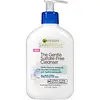What's inside
What's inside
 Key Ingredients
Key Ingredients

 Benefits
Benefits

 Concerns
Concerns

 Ingredients Side-by-side
Ingredients Side-by-side

Salicylic Acid 2%
MaskingWater
Skin ConditioningCocamidopropyl Betaine
CleansingSodium C14-16 Olefin Sulfonate
CleansingAloe Barbadensis Leaf Juice
Skin ConditioningGlycerin
HumectantNiacinamide
SmoothingCucumis Sativus Fruit Extract
EmollientLavandula Angustifolia Flower/Leaf/Stem Extract
MaskingChamomilla Recutita Flower Extract
MaskingCamellia Sinensis Leaf Extract
AntimicrobialArnica Montana Flower Extract
MaskingSalvia Officinalis Oil
MaskingMentha Piperita Oil
MaskingPanthenol
Skin ConditioningAllantoin
Skin ConditioningPotassium Sorbate
PreservativeSodium Benzoate
MaskingSodium PCA
HumectantEthylhexylglycerin
Skin ConditioningParfum
MaskingSalicylic Acid 2%, Water, Cocamidopropyl Betaine, Sodium C14-16 Olefin Sulfonate, Aloe Barbadensis Leaf Juice, Glycerin, Niacinamide, Cucumis Sativus Fruit Extract, Lavandula Angustifolia Flower/Leaf/Stem Extract, Chamomilla Recutita Flower Extract, Camellia Sinensis Leaf Extract, Arnica Montana Flower Extract, Salvia Officinalis Oil, Mentha Piperita Oil, Panthenol, Allantoin, Potassium Sorbate, Sodium Benzoate, Sodium PCA, Ethylhexylglycerin, Parfum
Water
Skin ConditioningGlycerin
HumectantSodium Methyl Cocoyl Taurate
CleansingCoco-Betaine
CleansingSodium Cocoyl Isethionate
CleansingSodium Chloride
MaskingPhenoxyethanol
PreservativePEG-100 Stearate
PPG-5-Ceteth-20
EmulsifyingGlyceryl Stearate
EmollientCoconut Acid
CleansingAcrylates/C10-30 Alkyl Acrylate Crosspolymer
Emulsion StabilisingCaprylyl Glycol
EmollientPEG-55 Propylene Glycol Oleate
Propylene Glycol
HumectantStyrene/Acrylates Copolymer
Salicylic Acid
MaskingChlorphenesin
AntimicrobialMethyldihydrojasmonate
MaskingSodium Hydroxide
BufferingHydrogenated Coconut Acid
EmollientPolyquaternium-53
Coco-Glucoside
CleansingDisodium EDTA
Sodium Isethionate
CleansingPEG-30 Dipolyhydroxystearate
EmulsifyingTrideceth-6
EmulsifyingBenzoic Acid
MaskingCitric Acid
BufferingBHT
AntioxidantCeramide AP
Skin ConditioningWater, Glycerin, Sodium Methyl Cocoyl Taurate, Coco-Betaine, Sodium Cocoyl Isethionate, Sodium Chloride, Phenoxyethanol, PEG-100 Stearate, PPG-5-Ceteth-20, Glyceryl Stearate, Coconut Acid, Acrylates/C10-30 Alkyl Acrylate Crosspolymer, Caprylyl Glycol, PEG-55 Propylene Glycol Oleate, Propylene Glycol, Styrene/Acrylates Copolymer, Salicylic Acid, Chlorphenesin, Methyldihydrojasmonate, Sodium Hydroxide, Hydrogenated Coconut Acid, Polyquaternium-53, Coco-Glucoside, Disodium EDTA, Sodium Isethionate, PEG-30 Dipolyhydroxystearate, Trideceth-6, Benzoic Acid, Citric Acid, BHT, Ceramide AP
Ingredients Explained
These ingredients are found in both products.
Ingredients higher up in an ingredient list are typically present in a larger amount.
Glycerin is already naturally found in your skin. It helps moisturize and protect your skin.
A study from 2016 found glycerin to be more effective as a humectant than AHAs and hyaluronic acid.
As a humectant, it helps the skin stay hydrated by pulling moisture to your skin. The low molecular weight of glycerin allows it to pull moisture into the deeper layers of your skin.
Hydrated skin improves your skin barrier; Your skin barrier helps protect against irritants and bacteria.
Glycerin has also been found to have antimicrobial and antiviral properties. Due to these properties, glycerin is often used in wound and burn treatments.
In cosmetics, glycerin is usually derived from plants such as soybean or palm. However, it can also be sourced from animals, such as tallow or animal fat.
This ingredient is organic, colorless, odorless, and non-toxic.
Glycerin is the name for this ingredient in American English. British English uses Glycerol/Glycerine.
Learn more about GlycerinSalicylic Acid (also known as beta hydroxy acid or BHA) is a well-known ingredient for treating skin that struggles with acne and clogged pores. It exfoliates both the skin's surface and deep within the pores to help clear out buildup, control oil, and reduce inflammation.
Unlike AHAs (alpha hydroxy acids), salicylic acid is oil-soluble. This allows it to penetrate into pores which makes it especially effective for treating blackheads and preventing future breakouts.
Salicylic acid is also known for its soothing properties. It has a similar structure to aspirin and can calm inflamed or irritated skin, making it a good option for acne-prone skin that is also sensitive.
Concentrations of 0.5-2% are recognized by the U.S. FDA as an over-the-counter topical acne product.
It can cause irritation and/or dryness if one's skin already has a compromised moisture barrier, so it's best to focus on repairing that before introducing this ingredient into your routine.
While salicylic acid does not increase sun sensitivity, it’s still important to wear sunscreen daily to protect your skin.
If you are looking for the ingredient called BHA or Butylated Hydroxyanisole, click here.
Learn more about Salicylic AcidWater. It's the most common cosmetic ingredient of all. You'll usually see it at the top of ingredient lists, meaning that it makes up the largest part of the product.
So why is it so popular? Water most often acts as a solvent - this means that it helps dissolve other ingredients into the formulation.
You'll also recognize water as that liquid we all need to stay alive. If you see this, drink a glass of water. Stay hydrated!
Learn more about Water